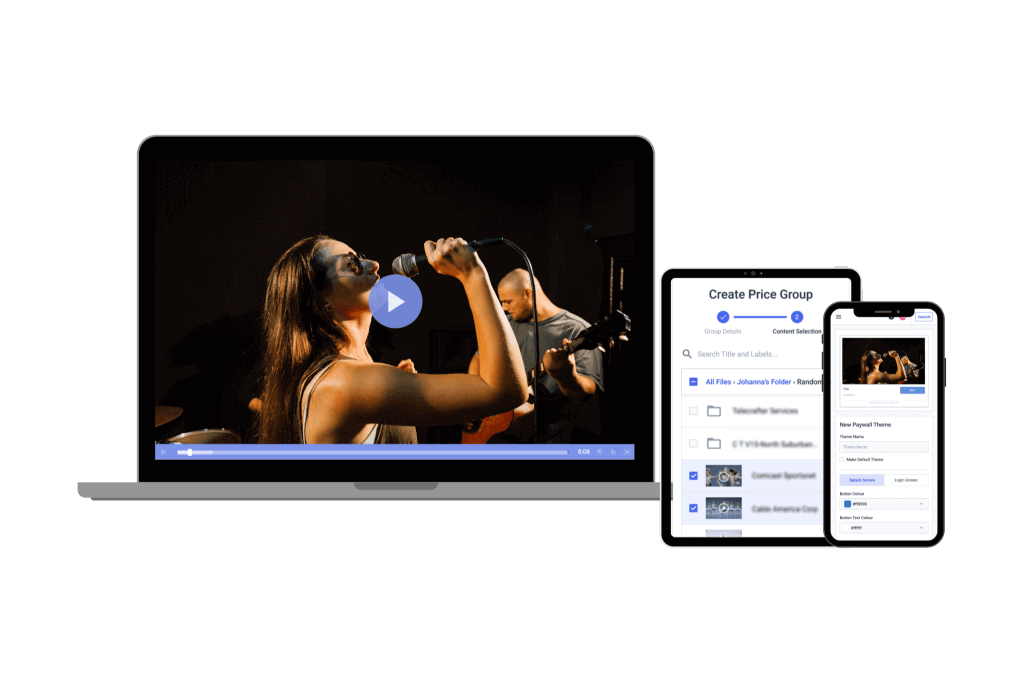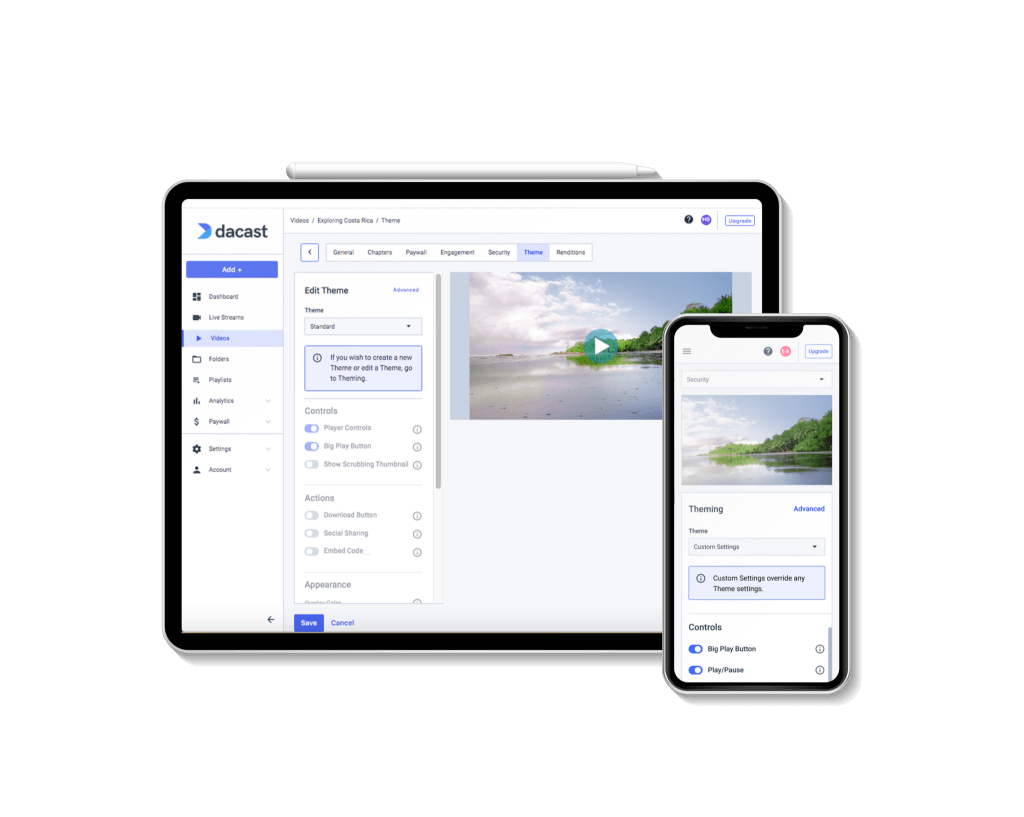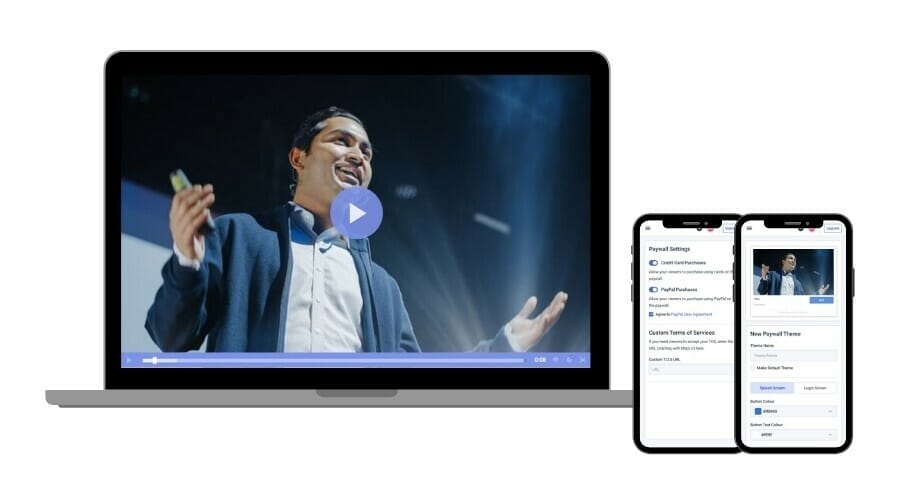The Definitive Guide to Video Streaming Technology in 2024
In this post, we’re going to break down everything you need to know about video streaming technology. We’re going to take a look at how streaming video works in general before looking at different types of live streaming technology and notable broadcasting tools and equipment. To wrap things up, we will review a couple of types of emerging streaming technology for 2024 and beyond.
Live streaming over the internet has evolved at a rapid rate over the past decade. New technology has improved and simplified the streaming experience for broadcasters and viewers alike.
Over the past year, in particular, the value of live streaming in every facet of life has really shone through. Live streaming makes it possible to host virtual events and reach viewers both near and far.
We are going to make sure you understand how video streaming technology works so you can use video streaming to further your business objectives.
Table of Contents
- What is Video Streaming Technology?
- How Does Streaming Video Technology Work?
- Video Streaming Basics
- Video Streaming Technology Stack
- Different Types of Video Streaming Technology
- 1. Streaming Protocols
- 2. Codecs
- 3. Video Players
- 4. Content Delivery Networks (CDNs)
- Notable Video Streaming Equipment and Tools
- Emerging Video Streaming Technology for 2024
- Conclusion
What is Video Streaming Technology?
Video streaming technology allows for the real-time delivery of video content over the internet without needing full file downloads. It includes stream technology, which breaks video files into small data packets which get sent sequentially to the viewer.
Internet video streaming enables on-demand and live video streaming technology which makes content accessible anytime, anywhere. Key components of the streaming infrastructure include servers, content delivery networks (CDNs), and streaming protocols. Examples of streaming technology include services such as Netflix and YouTube. As the video streaming market grows, understanding how video streaming works becomes evermore crucial for businesses looking to leverage this medium effectively.
What is Streaming Technology?
Streaming technology enables real-time delivery of video and audio content over the internet. It works by breaking down a video file into small packets of video data. These are then sent to viewer devices.
This allows for immediate playback without the need to wait for the video file to download. Video streaming services, such as Netflix and YouTube, use this technology to provide on-demand content. Also, live stream capabilities allow events to be broadcast in real-time. Streaming services use this technology to offer high-quality, seamless viewing audiences worldwide.
How Does Streaming Video Technology Work?


Online video streaming is a science that is still being optimized. However, the technology that is currently available is very powerful and makes it possible to stream video live.
Viewers from around the world can attend a single event without leaving the comfort of their homes. This has revolutionized the way that we learn and carry out business. It has even changed the way that we consume media and engage in activities for leisure. This is possible due to video streaming technology.
There is so much that goes on behind the scenes to bring viewers high-quality video content as it plays out in real-time. Before we dive into the nitty-gritty of these technologies, it is important to understand the path that a video takes from the time it is recorded on a camera until it reaches viewers’ screens.
The online video streaming setup typically looks like this:
- The camera captures RAW video
- Video is sent to the encoder via capture card or another hookup
- The encoder converts RAW video to a digital file
- Video is ingested into the online video platform
- The video is distributed from the online video platform to the video player via a content delivery network
- The video player displays the stream on the viewer’s internet-enabled device
This setup may vary, depending on the specific tools you’re using. Those are the basics of how online video streaming works.
Video Streaming Basics
Video streaming has changed the game in how content is consumed and distributed. It presents immense opportunities for broadcasters and businesses alike. At its core, video streaming technology involves delivering video and audio content over the internet in real-time. This allows viewers to watch video without the need to download files seamlessly.
Key to this is the video streaming infrastructure. This includes servers, CDNs, and streaming protocols. The infrastructure ensures the content is efficiently distributed and streamed to users across various devices. Then, encoding compresses the video into manageable sizes, while media servers store and deliver content. Embedded in websites and apps, players decode and play the streamed media.
Streaming media technology supports different types of streaming content such as live broadcasts, on-demand videos, and interactive streams. Furthermore, broadcast video technology integrates traditional TV and online platforms. This integration broadens reach and engagement. With continuous advancements in audio and video streaming technology, high-quality, low-latency streaming is more accessible than ever.
The latest streaming technology trends focus on enhanced viewer experience. This includes 4K resolution, adaptive bitrate streaming, and immersive VR/AR content. Understanding the basics of video streaming technology equips businesses and broadcasters with the tools they need to leverage these innovations. As a result, they ensure their content remains competitive in the ever-evolving landscape of online video streaming technologies.
Video Streaming Technology Stack
The video streaming technology stack is essential for delivering high-quality online video technology. This stack consists of several major components including encoding, streaming servers, content delivery networks (CDNs), and playback devices.
What is streaming technology and how does video streaming work? To understand what streaming technology entails begins with encoding. Encoding compresses the video into manageable sizes without sacrificing quality. Next, streaming server technology hosts and delivers the video to users. Then, CDNs distribute this content across global networks, reducing latency and buffering times.
How video streaming works on the web involves these components working together seamlessly. Let’s say a user requests a video. The encoded video file gets sent from the streaming server through the CDN to the user’s device. It’s here that a media player decodes and plays it for the user. Streaming technology examples that facilitate this include popular platforms such as Netflix and YouTube.
By grasping the video streaming basics, businesses can use the video streaming technology stack effectively to provide the best viewing experiences possible and remain competitive.
Different Types of Video Streaming Technology
From reviewing the video streaming setup we mentioned above, you can see that there are a lot of moving parts. Several different types of video streaming technology come together to create a seamless streaming experience.
The four major types of streaming technology include streaming protocols, codecs, video players, and content delivery networks. Each of these key components works together to transmit video from point A to point B.
Let’s take a closer look at each of these video streaming technologies and the roles that they play in online video streaming.
1. Streaming Protocols
Streaming protocols are standardized methods of delivering media across the internet. They take small chunks of data to make them light enough to carry over a variety of internet connections.
Protocols are important for broadcasting because they carry the content from one point to the next in the video streaming process.
There are several video streaming protocols that are important for live streaming. Let’s take a look at a few that are most commonly used today.
HLS
The HTTPS Live Streaming (HLS) protocol is one of the most important protocols in video streaming technology today. This protocol was founded by Apple to work with the HTML5 video player. It is used to deliver the media from the content delivery network to the user-facing player.
HLS can also be used for ingesting media from the encoder to the online video platform, but since HLS encoders are not that popular yet, HLS delivery is typically paired with RTMP ingest.
RTMP
Real-Time Messaging Protocol (RTMP) is another very important protocol that broadcasters use today. This was created to deliver content to Adobe’s Flash player, but since this video player has died out, it has assumed another role in streaming.
Today, this protocol is used for RTMP ingest. That means that it transports videos from the encoder to the online video platform or directly to the content delivery network.
RTMP provides the benefit of low-latency streaming and access to affordable RTMP encoders.
RTSP
Real-Time Streaming Protocol (RTSP) is a lesser-known protocol that is actually quite important. It is often confused with RTMP, but the two are not one and the same.
RTSP is used to carry commands from the user to the video player. For example, it tells the video player when the user is clicking Play, Pause, Fast-Forward, and other in-player commands.
RTSP is also valuable because it allows viewers to access video content before it is completely downloaded. This enhances the viewer experience because it doesn’t keep them waiting to play their desired content.
MPEG-DASH
MPEG-DASH is an open-source streaming standard that is structured similarly to HLS. What sets this standard apart is that it was the first to support adaptive bitrate streaming. This allows viewers to automatically access a stream in the quality that is best suited for their internet speed. That way, people with slower internet don’t experience excessive lagging and buffering.
MPEG-DASH is typically lumped in with streaming protocols, but it actually operates with the help of TCP, which is another protocol.
This standard is slowly gaining the support of related technology, so its compatibility is growing.
Streaming protocols are an essential piece of video streaming technology that allows for the smooth transportation of data over the internet.
2. Codecs
When you record a video on a camera, the RAW video files are made up of thousands of still frames that produce the fluid motion that we know as video. However, these files are very bulky which makes them un-streamable. In order for them to be made streamable, they need to be converted into a digital file.
In order to convert videos into a digital file, stills that are duplicates and deemed unnecessary are thrown out or compressed for transportation. A codec, which is a portmanteau for “coder-decoder,” is the technology that makes that happen. There are 2 types of codecs: audio codecs and video codecs.
Basically, a codec packs up the video files that it receives, transports them from one stop in the streaming process to the next. They keep their contents compact to make it easy for them to travel over the internet.
The tools that use codecs are called “encoders.” There are both hardware and software encoders, and we will talk more about these tools a little later on.
Encoders are a vital piece of video streaming technology that takes your RAW video files, and turns them into digital files that can be shared online.
3. Video Players


A video player is a user-facing technology that lets viewers see a video stream. In the past, Adobe’s Flash player was the standard, but since it was not compatible with mobile streaming, it has since become obsolete.
The HTML5 video player has since become the industry standard. This video player was founded by Apple to support mobile video streaming. The HTML5 video player is supported on pretty much any internet-enabled device thinkable, including smartphones, tablets, smart TVs, and gaming consoles. HTML5 is also compatible with most browsers and operating systems.
In addition to ultra-compatibility, HTML5 video players are very secure and easily customizable. Since it has so many benefits for broadcasters, HTML5 is the standard for most live streaming platforms.
A video player is a user-facing piece of video streaming technology that allows the end-user to watch your content.
4. Content Delivery Networks (CDNs)
A content delivery network (CDN) is a series of servers that are strategically placed over a geographic region to deliver high-quality content to locations that are remote from the stream’s source.
How it works is the streaming CDN sends the content to a network of servers. Users select their desired content via video players connected to the online video platform. From there, the CDN will redirect the request from the originating site’s server to a server in the CDN that is closest to the user and deliver the cached content.
By having servers placed closer to both the origination point and the destination, content can be delivered much faster.
Many broadcasters access CDNs via partnerships formed via their selected online video platform. Dacast, for example, partners with Akamai, Limelight, and other top-tier CDNs to provide fast, high-quality streaming to viewers around the world.
Take a look at our comparison of video CDNs for video streaming to learn more about the top options on the market.
A content delivery network is an essential piece of video streaming technology that ensures you are able to get your content to your viewers smoothly around the world.
Notable Video Streaming Equipment and Tools
There are several tools, including a variety of hardware and software, that brings all of this technology to life to make broadcasting easy for professionals without much technical know-how.
Let’s take a look at a few important tools for online video streaming.
Online Video Hosting Platform
One of the most important video streaming tools is an online video platform (OVP). This tool brings all of the other technology together and streamlines the broadcasting experience. A well-equipped OVP makes it possible for even brand new broadcasters to get into the online video streaming game.
A video hosting platform does more than just host your videos, it provides you with a range of services and tools, such as:
- HTML5 video player
- Automatic transcoding
- Adaptive bitrate streaming
- Global video delivery
- Monetization and advertising
- Security and access control
Audio and Video Capture Equipment
Streaming equipment to capture your stream is non-negotiable. You need a reliable camera and audio capturing tools to record your stream.
There are quite a few different cameras you can choose from for online video streaming, ranging from a simple webcam to a professional streaming camcorder. We recommend checking out our list of suggested live streaming cameras to see some of the top options on the market.
As for audio and mobile capture equipment, sometimes the microphone that is built into the camera will do, but an external microphone is a quick fix that will take your audio quality to the next level. A simple handheld or lapel clip microphone is a small investment that can give your stream a more professional touch.
Having the right equipment makes it easier to produce high-quality live streams.
Encoding Hardware or Software
Encoding is another important part of the online streaming process. As we discussed before, encoding is what converts RAW videos to digital videos, which is important for streaming over the internet.
Broadcasters can choose from hardware and software encoders. In general, hardware encoders are much more expensive, but they are dedicated devices, which makes them a bit more powerful. Software encoders are much more affordable, and some are even free. Encoding software is almost as powerful as hardware encoders, and they can be updated like any other software.
Emerging Video Streaming Technology for 2022


Video streaming technology is still evolving at a rapid rate. New developments continue to push the boundaries of what is possible and improve different aspects of online streaming. For example, some emerging technology is simply improving quality and experience while another new technology is exploring uncharted territories.
Here are a few examples of innovative streaming technology that you should keep an eye out for as they continue to develop and grow in popularity.
WebRTC
WebRTC is an emerging streaming project that was founded by Google to support real-time latency and peer-to-peer streaming.
WebRTC is currently used in a number of video conferencing apps, but online video platforms are slowly adapting to support this protocol to tap into its ultra-low latency capabilities. Although WebRTC is still a work in progress the future of the project will depend on how related live streaming tools adapt to support it.
SRT
SRT is a developing streaming protocol that is known for low latency and reliable security. With those two characteristics and others, SRT is capable of streaming at a level that matches the combined forces of RTMP and HLS.
Another major benefit of SRT is that it is responsive. That means that it adjusts its carrying capacity based on the speed of the internet to avoid buffering, lagging, and failure.
At this time, very few online video platforms support SRT, but this protocol will likely continue to grow in popularity as more video streaming tools become accommodating.
Immersive Video Streaming
Immersive video streaming is another hot streaming technology that lies before us. This is a style of experiential streaming that helps viewers feel like they are in the video. There are a few types of immersive streaming including virtual reality and 360 video streaming.
360 video streaming uses a filming style that captures video from what would be the viewers’ point of view. This is relatively easy content to create, and it can be accessed on a regular video player. Simple cinematic elements can help to improve the user experience.
Virtual reality (VR) is a bit more advanced, and it requires a special headset for viewers to consume and experience. It also takes some more advanced work on the development side. In VR, viewers can move freely around the augmented reality.
Immersive streaming can be a great tool in both professional and casual settings. Immersive streaming has been used to enhance different areas of business, and it is also used for entertainment purposes.
This technology is still developing, so it will be interesting to see where it goes.
Ultra-High Definition Streaming
In recent years, high-definition 4K streaming was seen as an incredible feat. However, 5K and 6K streaming are on the horizon as cameras become more advanced and streaming infrastructure becomes more powerful.
Although cameras are capable of 5K and 6K streaming, the rest of the streaming technology is still catching up.
Conclusion


CAPTION: Are you ready to start streaming online?
Online video streaming is very important to businesses and organizations that are looking to engage with their current audiences and extend their reach to new viewers.
Although some of the live streaming software technology we’ve mentioned in this post might sound complex or confusing, most broadcasters can get away with just knowing the basics. When you use a professional streaming solution, like Dacast, a lot of the “behind the scenes” technology is automatically configured. However, having a general idea of how it all works will help you make educated decisions throughout the process.
Looking for a powerful online video platform to help you start streaming? Dacast may be the option for you. Our platform is equipped with all of the tools that broadcasters need to host, manage, and deliver high-quality video content. Dacast offers white-label streaming, global content delivery, video monetization, top-notch security, and more.
You can try Dacast risk-free for 14 days by signing up for a free trial. Test all of our features and host a stream to see how our platform can work for you. Sign up today to get started. No contract, sign-up fees, or credit card required.
You can try Dacast and all its features free for 14 days, today.
For regular tips on live streaming, you’re welcome to join our LinkedIn group.

 Connect
Connect
 Events
Events Business
Business Organizations
Organizations Entertainment and Media
Entertainment and Media API
API Tools
Tools Learning Center
Learning Center Support
Support Support Articles
Support Articles